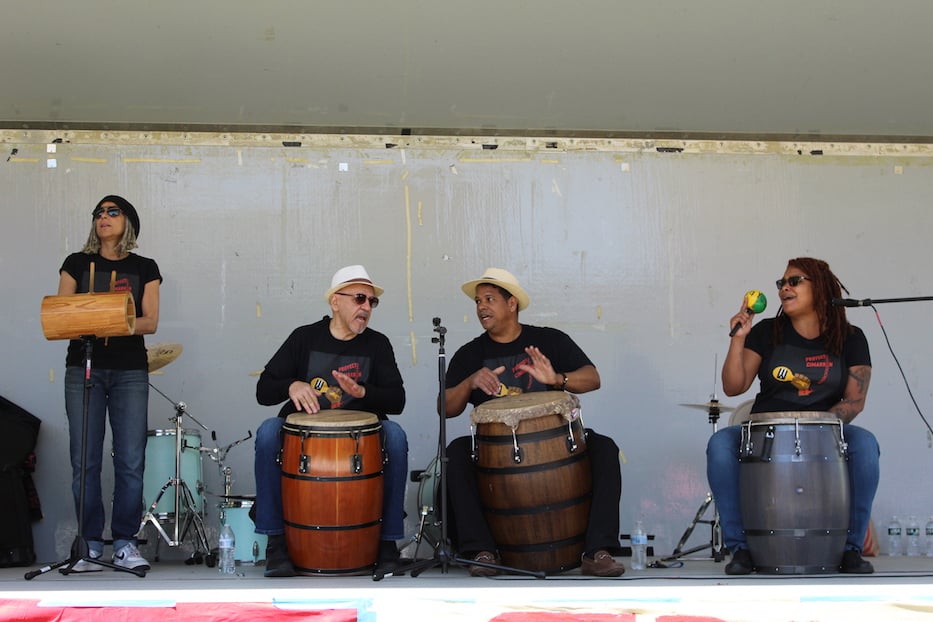
Cuá player Monica “Cuqui” Matos, Asher Delerme, Carlos Cruz, and Addys Castillo. Al Larriva-Latt Photos.
Sun warmed the New Haven Green. Atop a stage rising four feet into the air, members of Proyecto Cimarrón—four percussionists and two dancers—adjusted their equipment. The grassy area below the stage was nearly empty.
Then Addys Castillo began to sing. Her voice—steady, forceful, fierce—carried across the Green, across Church Street, down towards State Street. Three percussionists beat their palms against their upright barriles (barrel drums). A fourth hit sticks against her custom-made cuá. The waves of traffic and pedestrians began to stir.
With electrifying rhythm, melody, and movement, Proyecto Cimarrón kicked off May Day on the New Haven Green, a six-hour festival complete with music, food, informational booths, and a culminating march. Unidad Latina Acción (ULA), a New Haven-based immigrant rights grassroots social justice group, organized the event.
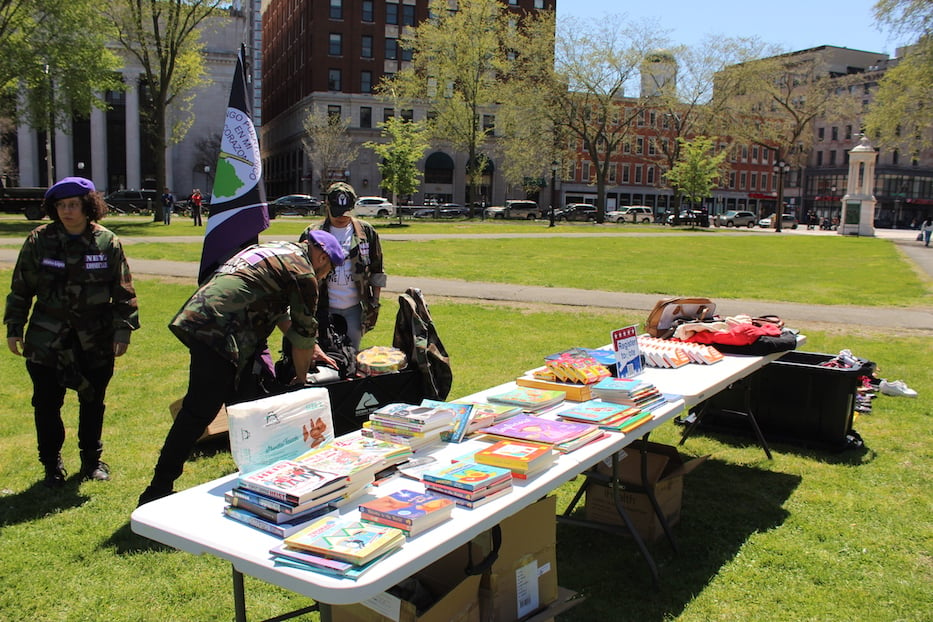
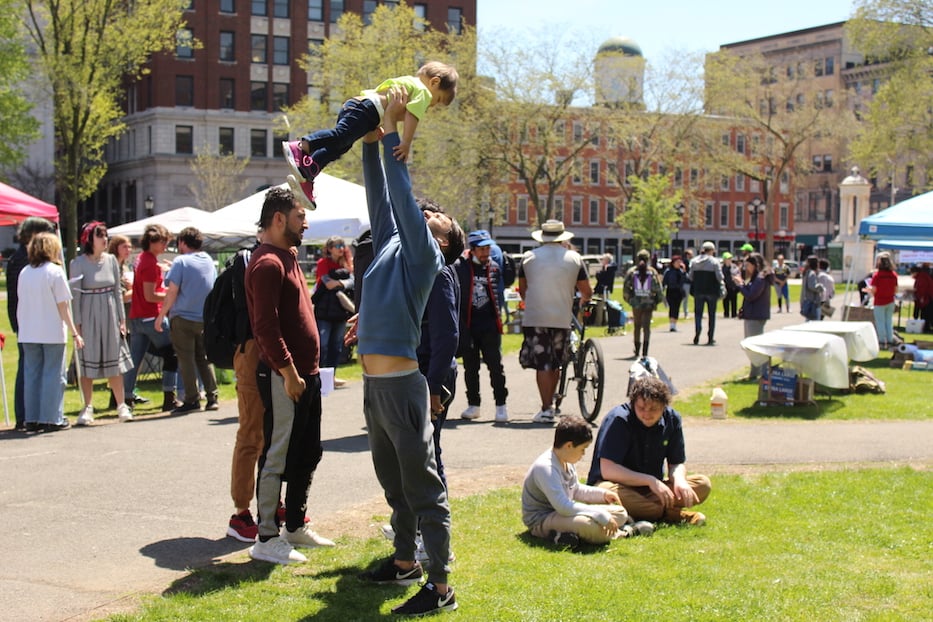
Top: Among the NEYL's spread of mutual aid items were children's books, rapid Covid tests, and clothing and shoes. Bottom: Joy!
Formed in late 2021, the New-Haven-based Proyecto Cimarrón is a multi-generational collective of Puerto Rican musicians. Its members play Bomba, a folkloric musical tradition that enslaved people in Puerto Rico used as a tool of resistance. The group is quick to honor the Black roots of the art form and its enduring legacy. Members include Castillo, Carlos Cruz, Asher Delerme, sisters Kica and Monica Matos, and sisters Naomy and Natasha Velez; read more about the group’s beginnings here and here.
“Cimarrón, in case you don’t know, in Spanish, it’s a word loosely translated meaning ‘Maroon,’” Castillo said. “But in Puerto Rico ‘cimarrónes’ is the name they gave to the enslaved folks who ran away into hiding and into revolution.”
May Day—which falls on May 1–is a global celebration of workers’ rights. What may be New Haven’s most well-known celebration of May Day took place in 1970, when approximately 15,000 people flooded the Green in solidarity with Bobby Seale and Ericka Huggins.
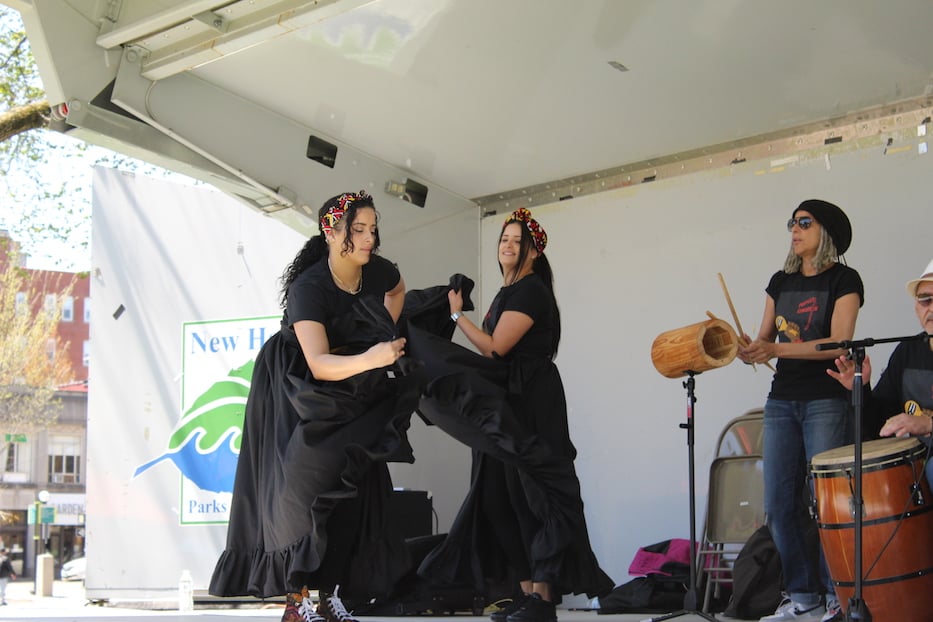
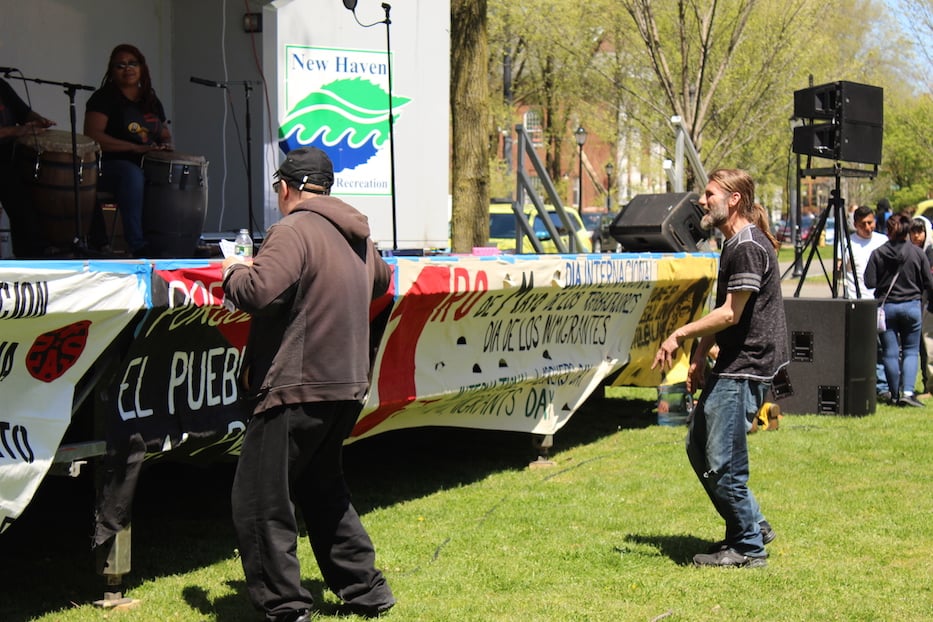
Top: Bailadoras Naomy and Natasha Velez. Bottom: The grass of the New Haven Green became a dance floor.
As Proyecto Cimarrón initiated Sunday’s festivities, people began flocking to the stage. By the end of the song, over 30 audience members had turned the grass into a dance floor, swaying, twirling one another in circles, bobbing their heads, and rocking their sneakers to the percussion. In five minutes flat, the New Haven Green had transformed into a full-on celebration.
“We like to use Bomba as a gateway to advance social justice movements. The drums are so much louder than 10 voices. It picks up,” said cuá player Monica “Cuqui” Matos.
The party continued on the grassy dance floor. Two parents with two teenage girls in tow ambled over and immediately began to dance, shaking their arms and legs to the rhythm. An organizer wearing bright yellow Doc Marten boots bolted from the ULA booth onto the grass, followed close behind by another ULA organizer. Both took turns twirling one another to the beat of the drums.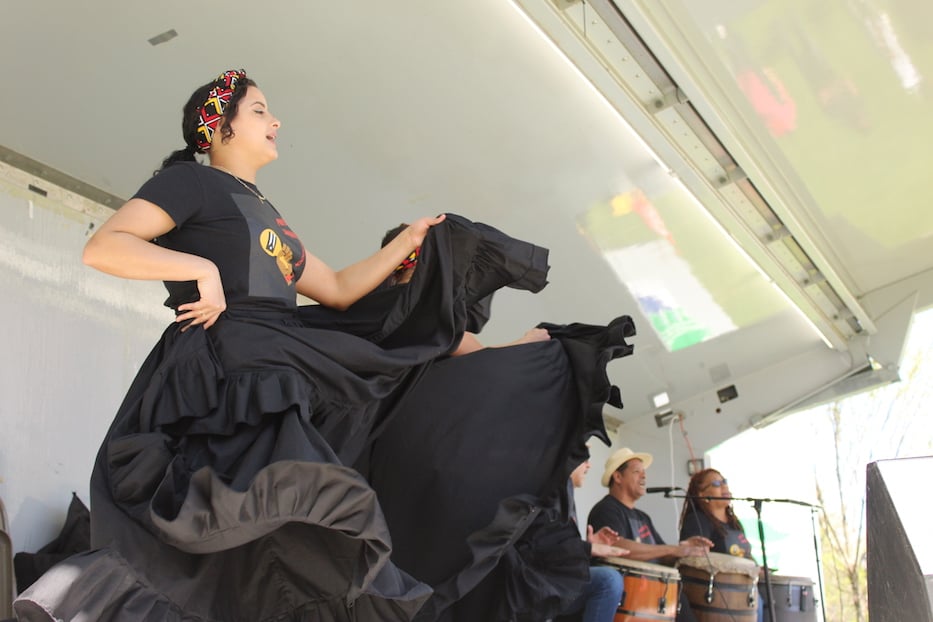
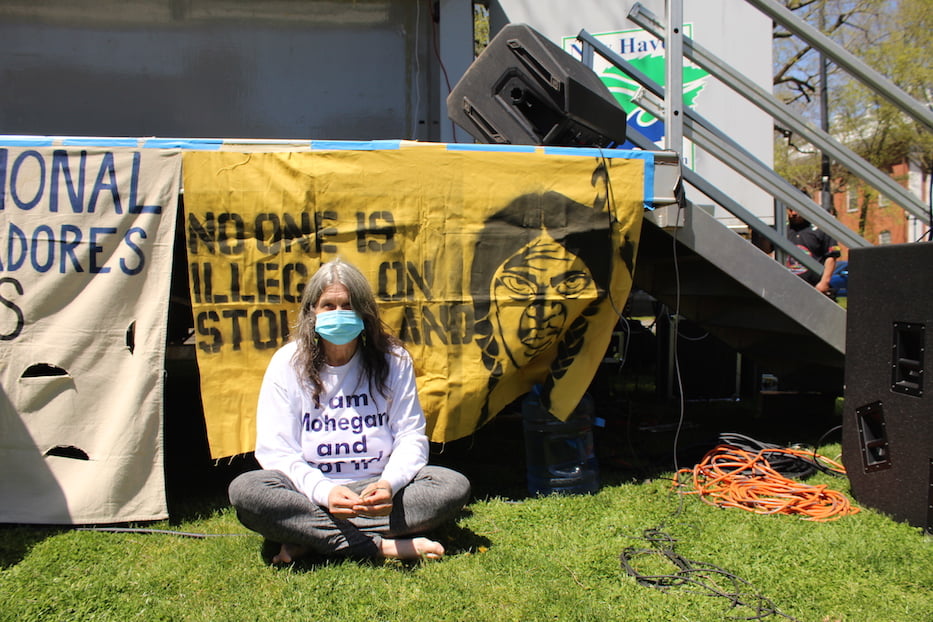
Mountain Flower.
Off to the side sat Mountain Flower, who also goes by the name of Sherry Fields, wearing a cotton t-shirt that proudly repped her Mohegan tribe. Cradling a bird feather in her hand, she posed below a homemade banner on the stage, which read in all caps: “No one is illegal on stolen land.”
Surrounding the concert were approximately six different social justice booths of organizations, whose causes echoed and reinforced Proyecto Cimarrón’s song and dance of resistance.
.jpg?width=933&name=Posing%20with%20the%20multi-colored%20New%20Era%20Young%20Lords%20(NEYL).jpg)
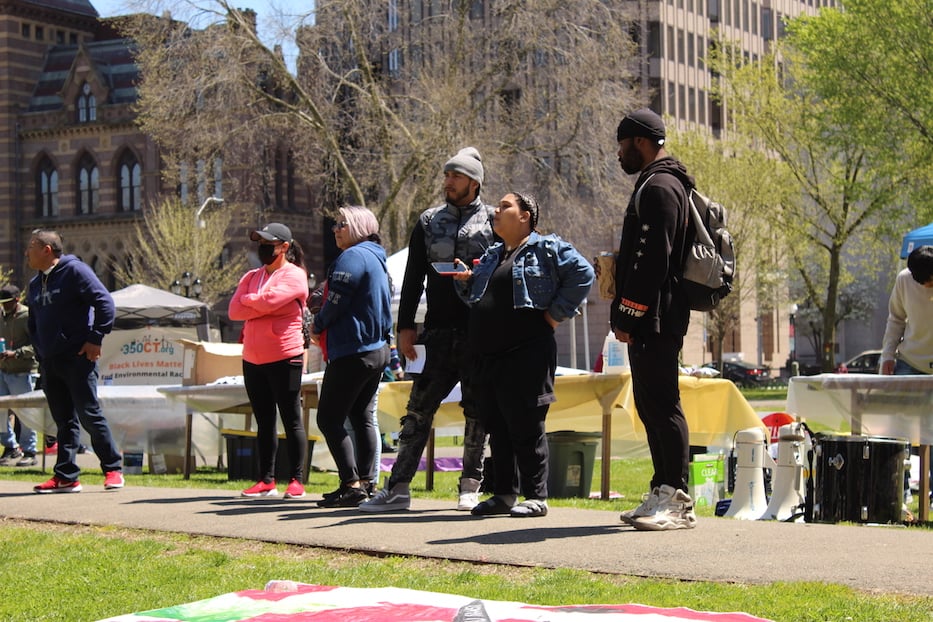
The New Era Young Lords (NEYL), who champion self-determination, were situated farthest from the stage. Behind their table, two members staked a purple, black, white flag into the ground. In the center of the flag was the image of a golden fist lofting a rifle into the air. The text of the flag pledged in Spanish, “Tengo Puerto Rico en Mi Corazón.” (Puerto Rico is in my heart). The slogan is a nod to the group’s revolutionary beginnings in the 1970s, during which members advocated for Puerto Rican independence.
Clothed in camouflage military fatigues, with purple berets atop their heads, the NEYL members walked along the length of the table, encouraging passerby to take from the thoughtful arrangement of mutual aid items on the table. There were children’s books, rapid Covid tests, and an assortment of clothing, shoes, and handbags.
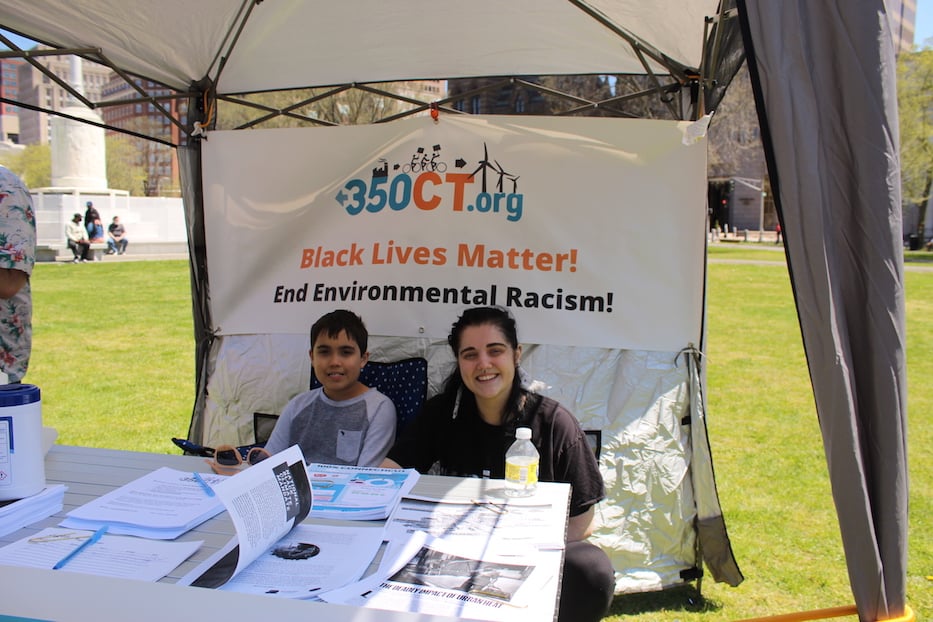
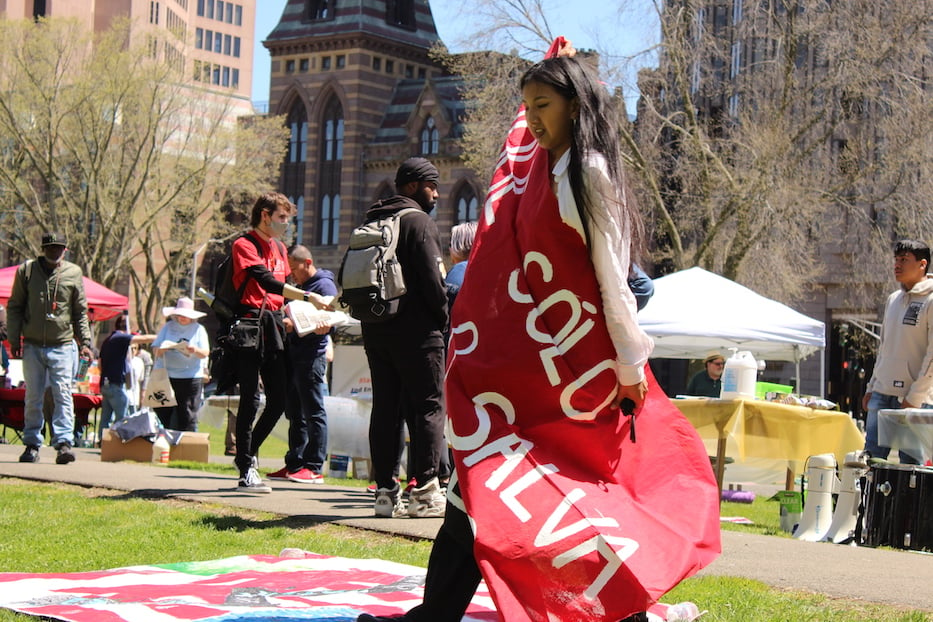
Top: Rachel Loncher and her nephew Preston. Bottom: Transporting a homemade banner to the stage.
Farther along the pathway was Connecticut 350, a climate justice organization. Organizer Rachel Loncher sat with her elementary school-age nephew Preston, encouraging passerby to sign up for the group’s email list. To Loncher’s right was the People’s World Committee, whose members passed out Spanish and English copies of their self-published flier “The Worker’s Voice.”
Across the way was Unidad Latina Acción. Their booth was stocked with bottled water, soda, chip bags, and bananas—all free to passerby.
Proyecto Cimarrón began a sica rhythm, four-four count. It was a call and response song about Alejandra Martinez, a woman with dark skin who danced bomba. “Ale, Ale,” buleador and singer Castillo called, her lyrics reaching out to her fellow performers. “Ale, Ale, Alejandra Martinez,” the five other members of Proyecto Cimarrón responded.
Bailadores (dancers) Nayomi and Natasha Velez wore wide black skirts, which fanned out across the lower half of their bodies. With their hands fastened to their skirts’ folds, the Velez sisters thrust their hands left to right, and then in front of their bodies, allowing the momentum of the gesture to lead their rubber-soled feet across the stage.
In their final song, the percussionists’ hands flew. Over and over, the Velez sisters swept their skirts 180 degrees, like windshield wipers. El primo Carlos Cruz (the primary drummer) was poised behind his drum, his eyes fixed upon the sisters’ movement. Los dos buleadores—the two secondary drummers—beat their barriles in complementary rhythms to that of Cruz’. At the end of the song, the crowd erupted in gritos y aplausos (shouts and cheers). The Green filled with the sounds of resistance and solidarity.
“The more energy that’s picked up collectively, the better. The greater the feeling, the greater the joy," Matos said, reflecting on the performance. "It’s infectious."
To learn more, visit the collective’s website.